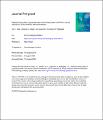Reduced firing rates of pyramidal cells in the frontal cortex of APP/PS1 can be restored by acute treatment with levetiracetam
Klee, J. L., Kiliaan, A. J., Lipponen, A., & Battaglia, F. P. (2020). Reduced firing rates of pyramidal cells in the frontal cortex of APP/PS1 can be restored by acute treatment with levetiracetam. Neurobiology of Aging, 96, 79-86. https://doi.org/10.1016/j.neurobiolaging.2020.08.013
Published in
Neurobiology of AgingDate
2020Copyright
© 2020 Elsevier
In recent years aberrant neural oscillations in various cortical areas have emerged as a common physiological hallmark across mouse models of amyloid pathology and patients with Alzheimer's disease. However, much less is known about the underlying effect of amyloid pathology on single cell activity. Here, we used high density silicon probe recordings from frontal cortex area of 9 months old APP/PS1 mice to show that Local Field Potential (LFP) power in the theta and beta band is increased in transgenic animals, while single cell firing rates, specifically of putative pyramidal cells, are significantly reduced. At the same time, these sparsely firing pyramidal cells phase-lock their spiking activity more strongly to the ongoing theta and beta rhythms. Furthermore, we demonstrated that the anti-epileptic drug, levetiracetam, counteracts these effects by increasing pyramidal cell firing rates in APP/PS1 mice and uncoupling pyramidal cells and interneurons. Overall, our results highlight reduced firing rates of cortical pyramidal cells as a pathophysiological phenotype in APP/PS1 mice and indicate a potentially beneficial effect of acute levetiracetam treatment. ...
...
 ...
...
Publisher
ElsevierISSN Search the Publication Forum
0197-4580Keywords
Publication in research information system
https://converis.jyu.fi/converis/portal/detail/Publication/41867727
Metadata
Show full item recordCollections
Additional information about funding
The study was supported by the Säätiöiden post doc -pooli (The Finnish Cultural Foundation) to Dr. Arto Lipponen. Silicon probes were manufactured by IMEC (Leuven, Belgium) with funding from the European Union’s Seventh Framework Programme (FP7/2007-2013) under grant agreement nr. 600925 (NeuroSeeker).License
Related items
Showing items with similar title or keywords.
-
Characterization of epileptic spiking associated with brain amyloidosis in APP/PS1 mice
Gureviciene, Irina; Ishchenko, Irina; Ziyatdinova, Sofya; Jin, Nanxiang; Lipponen, Arto; Gurevicius, Kestutis; Tanila, Heikki (Frontiers Media, 2019)Epileptic activity without visible convulsions is common in Alzheimer’s disease (AD) and may contribute adversely to the disease progress and symptoms. Transgenic mice with amyloid plaque pathology also display epileptic ... -
Active Gains in brain Using Exercise During Aging (AGUEDA) : protocol for a randomized controlled trial
Solis-Urra, Patricio; Molina-Hidalgo, Cristina; García-Rivero, Yolanda; Costa-Rodriguez, Claudia; Mora-Gonzalez, Jose; Fernandez-Gamez, Beatriz; Olvera-Rojas, Marcos; Coca-Pulido, Andrea; Toval, Angel; Bellón, Darío; Sclafani, Alessandro; Martín-Fuentes, Isabel; Triviño-Ibañez, Eva María; de Teresa, Carlos; Huang, Haiqing; Grove, George; Hillman, Charles H.; Kramer, Arthur F.; Catena, Andrés; Ortega, Francisco B.; Gómez-Río, Manuel; Erickson, Kirk I.; Esteban-Cornejo, Irene (Frontiers Media, 2023)Alzheimer’s disease is currently the leading cause of dementia and one of the most expensive, lethal and severe diseases worldwide. Age-related decline in executive function is widespread and plays a key role in subsequent ... -
Physical Performance and Amyloid-β in Humans : A Systematic Review and Meta-Analysis of Observational Studies
Solis-Urra, Patricio; Rodriguez-Ayllon, María; Álvarez-Ortega, Miriam; Molina-Hidalgo, Cristina; Molina-Garcia, Pablo; Arroyo-Ávila, Cristina; García-Hermoso, Antonio; Collins, Audrey M.; Jain, Shivangi; Gispert, Juan Domingo; Liu-Ambrose, Teresa; Ortega, Francisco B.; Erickson, Kirk I.; Esteban-Cornejo, Irene (IOS Press, 2023)Background: Accumulation of amyloid-β (Aβ) plaques is one of the main features of Alzheimer’s disease (AD). Physical performance has been related to dementia risk and Aβ, and it has been hypothesized as one of the mechanisms ... -
Associations of Genetic Susceptibility to Alzheimer’s Disease with Adiposity and Cardiometabolic Risk Factors among Children in a 2-Year Follow-up Study
Haapala, Eero; Paananen, Jussi; Hiltunen, Mikko; Lakka, Timo A. (IOS Press, 2018)We investigated the associations of genetic risk score (GRS) for Alzheimer’s disease and apolipoprotein E (APOE) ɛ variant with cardiometabolic risk factors during 2-year follow-up in children and whether body fat percentage ... -
Physical activity may not be associated with long‐term risk of dementia and Alzheimer’s disease
Kunutsor, Setor K.; Laukkanen, Jari A.; Kauhanen, Jussi; Willeit, Peter (Wiley, 2021)Background While it is well established that physical activity is associated with reduced risk of vascular and non‐vascular outcomes as well as mortality, evidence on the association between physical activity and dementia ...

